Life Extension of Aged Jointed Plain Concrete Pavement through Remodeling Index–Based Analysis
Abstract
:1. Introduction
2. RMI (Remodeling Index) System
2.1. RMI (Remodeling Index)
2.2. RMIpresent (Remodeling Index Present)
2.3. △RMI (△Remodeling Index)
2.4. △SD (△Surface Distress) and △IRI(△International Roughness Index)
3. RMI (Remodeling Index) Factor Analysis
3.1. RMI (Remodeling Index) by ASR (Alkali-Silica Reaction) Grade
3.2. △IRI (△International Roughness Index) by Section and ASR (Alkali-Silica Reaction) Grade
3.3. △RMI (△ Remodeling Index) by ASR (Alkali-Silica Reaction) Grade
3.4. Relationship of △IRI (△International Roughness Index) with Traffic Volume and Pavement Age
3.5. Effect of Pavement Age on △SD (△Surface Distress)
3.6. Effect of Forecast Year N and ASR (Alkali-Silica Reaction) on RMI (Remodeling Index)
4. Applying Preventive Maintenance on the Basis of RMI (Remodeling Index)
4.1. IRI (International Roughness Index)-Based Preventive Maintenance
4.2. SD (Surface Distress)-Based Preventive Maintenance
4.3. SD (Surface Distress) and IRI (International Roughness Index)-Based Preventive Maintenance
5. Conclusions
- The higher the ASR grade and the further into the future the forecast year, the higher the number of target sections for remodeling. The more maintenance is delayed, the higher the maintenance cost.
- Although the ASR grade did not substantially affect △IRI, the effect of ASR is expected to increase with increase in the RMI forecast year N.
- Regarding the effect of ASR on RMI, the range of increase according to ASR grade was larger than the change in △IRI, and the impact of △IRI was greater than △SD.
- As traffic volume and pavement age increased, △IRI tended to increase, but this increase was concentrated within 15–20 years of pavement age. Therefore, in sections with high traffic volume and pavement age, preventive maintenance is a must even if the RMI is low.
- As pavement age increased, △SD tended to increase, but this increase was concentrated within 15–20 years of pavement age. That is, △SD changed little in sections with healthy pavement, but the concrete pavement underwent intensive damage after 15 years of age.
- The effect of ASR grade on RMI increased with increase in the forecast year. Therefore, preventive maintenance is a must for sections with a high ASR grade even when the RMI is low. In addition, when the RMI is high, timely resurfacing and O/L are essential as deterioration accelerates with delay in repair.
- Diamond grinding decreases the number of sections requiring resurfacing and O/L. Thus, to extend the life of the pavement, diamond grinding can be used as a preventive maintenance to achieve an IRI of 1.5 or lower.
- Smoothness repair is more advantageous than damage repair in terms of preventive maintenance. However, both SD damage repair and IRI smoothness repair can be implemented together to extend the service life of concrete pavements.
Author Contributions
Funding
Conflicts of Interest
References
- Suh, Y.-C.; Park, J.-W.; Kim, C.-W. Case Studies of the Life Cycle Cost Analysis for Rehabilitation of Deteriorated Expressway Concrete Pavements. Int. J. Highw. Eng. 2016, 18, 33–45. [Google Scholar] [CrossRef]
- Weather Data Opening Portal. Available online: https://data.kma.go.kr/cmmn/main.do (accessed on 2 January 2020).
- Development of High-Performance Concrete Pavement Maintenance Technology to Extend Roadway Life. Available online: https://www.kaia.re.kr/portal/landmark/readTskView.do?tskId=146707&yearCnt=1&cate1=&cate2=&cate3=&year=&bizName=&psnNm=&orgNm=&tskName=%EB%8F%84%EB%A1%9C%EC%88%98%EB%AA%85&sort=&pageIndex=1&menuNo=200060#none (accessed on 2 January 2020).
- Nam, J.-H.; Jeon, S.-II.; Ahn, J.-H. Long-Term Performance Evaluation of Concrete Pavement Overlay on Deteriorated Jointed Plain Concrete Pavement. Int. J. Highw. Eng. 2018, 20, 89–99. [Google Scholar] [CrossRef]
- Kim, D.-H.; Lee, J.-M.; Moon, K.-H.; Park, J.-S.; Suh, Y.-C.; Jeong, J.-H. Development of Remodeling Index Model to Predict Priority of Large-Scale Repair Works of Deteriorated Expressway Concrete Pavements in Korea. KSCE J. Civ. Eng. 2019, 23, 2096–2107. [Google Scholar] [CrossRef]
- Lukovic, M.; Ye, G.; Van Breugel, K. Reliable Concrete Repair—A Critical Review. In Proceedings of the International Conference Structural Faults & Repair, Edinburgh, Scotland, UK, 3–5 July 2012. [Google Scholar]
- Muhammad, M. Identification of Pavement Distress Types and Pavement Condition Evaluation Based on Network Level Inspection for Jazan City Road Network. J. Eng. Res. 2014, 11, 44–45. [Google Scholar]
- American Association of State Highway and Transportation Officials (AASHTO). Guide for Design of Pavement Structures; AASHTO: Washington, DC, USA, 1993. [Google Scholar]
- Pantuso, A.; Loprencipe, G.; Bonin, G.; Teltaye, B.B. Analysis of Pavement Condition Survey Data for Effective Implementation of a Network Level Pavement Management Program for Kazakhstan. Sustainability 2019, 11, 901. [Google Scholar] [CrossRef] [Green Version]
- Lee, S.-W.; Son, H.-J. Comparison of the Pavement Performance for Concrete Overlay and Asphalt Overlay on Aged Cement Concrete Pavement. Int. J. Highw. Eng. 2011, 13, 31–39. [Google Scholar] [CrossRef] [Green Version]
- Pierce, L.M.; McGovern, G.; Zimmerman, K.A. Practical Guide for Quality Management of Pavement Condition Data Collection, Final Document; Applied Pavement Technology, Inc.: Urbana, IL, USA, 2013. [Google Scholar]
- Shahnazari, H.; Tutunchian, M.A.; Mashayekhi, M.; Amini, A.A. Application of Soft Computing for Prediction of Pavement Condition Index. J. Transp. Eng. 2012, 138, 1495–1506. [Google Scholar] [CrossRef]
- De Florio, J.; Louch, H. Local Pavement Management Systems, Final Report; Cambrigde Systematics, Inc.: Cambridge, MA, USA, 2014. [Google Scholar]
- Khattak, M.J.; Baladi, G.; Zhang, Z.; Ismail, S. Review of Louisiana’s Pavement Management System: Phase I. Transp. Res. Rec. J. Transp. Res. Board 2008, 2084, 18–27. [Google Scholar] [CrossRef]
- Trombetta, J.; Pandolfo, A.; Goldoni, A.; Gomes, A.P.; Secht, L.P. Caracterização das ocorrências de defeitos em pavimentos asfálticos na cidade de Pato Branco–PR. Rev. Tecnol. 2010, 31, 239–247. [Google Scholar]
- Soncim, S.P.; Fernandes, J.L., Jr. Modelo de previsão do índice de condição dos pavimentos flexíveis. J. Transp. Lit. 2015, 9, 25–29. [Google Scholar] [CrossRef] [Green Version]
- Lopes, S.B.; Pfaffenbichler, P.; Emberger, G.; Riedl, L.; Fernandes, J.L., Jr. Gerência de pavimentos urbanos com uso de modelagem dinâmica de sistemas diretamente conectada com um SIG. In Proceedings of the Congresso de Pesquisa e Ensino em Transportes, Fortaleza, Brazil, 3–7 November 2008. [Google Scholar]
- Arhin, S.A.; Williams, L.N.; Ribbiso, A.; Anderson, M.F. Predicting pavement condition index using international roughness index in a dense urban area. J. Civ. Eng. Res. 2015, 5, 10–17. [Google Scholar]
- Boyapati, B.; Kumar, R.P. Prioritisation of pavement maintenance based on pavement condition index. Indian J. Sci. Technol. 2015, 8, 1–5. [Google Scholar] [CrossRef]
- Pinatt, J.M.; Chicati, M.L.; Ildefonso, J.S.; Filetti, C.R.G.D.A. Evaluation of pavement condition index by different methods: Case study of Maringá, Brazil. Transp. Res. Interdiscip. 2020, 2020, 100100. [Google Scholar] [CrossRef]
- Jung, Y.S.; Lin, W.; Hao, H.; Cho, Y.H. Interface behavior of partial depth repair for airport concrete pavement subjected to differential volume change. Constr. Build. Mater. 2017, 143, 515–521. [Google Scholar] [CrossRef]
- Lee, E.B.; Lim, S.W.; Hartog, J.C.; Thomas, D.K. I-15 Ontario project: Technology implementation for accelerated concrete pavement rehabilitation. In Proceedings of the National Conference on Preservation, Repair, and Rehabilitation of Concrete Pavements, St. Louis, MO, USA, 21–24 April 2009; pp. 303–316. [Google Scholar]
- Pérez-Acebo, H.; Linares-Unamunzaga, A.; Rojí, E.; Gonzalo-Orden, H. IRI Performance Models for Flexible Pavements in Two-Lane Roads until First Maintenance and/or Rehabilitation Work. Coatings 2020, 10, 97. [Google Scholar] [CrossRef] [Green Version]
- Haider, S.W.; Chatti, K.; Zaabar, I.; Eisma, R.J.; Frederick, T. Impact of Diamond Grinding on Rigid Pavement Performance. Airfield Highw. Pavements 2015, 2015, 500–511. [Google Scholar]
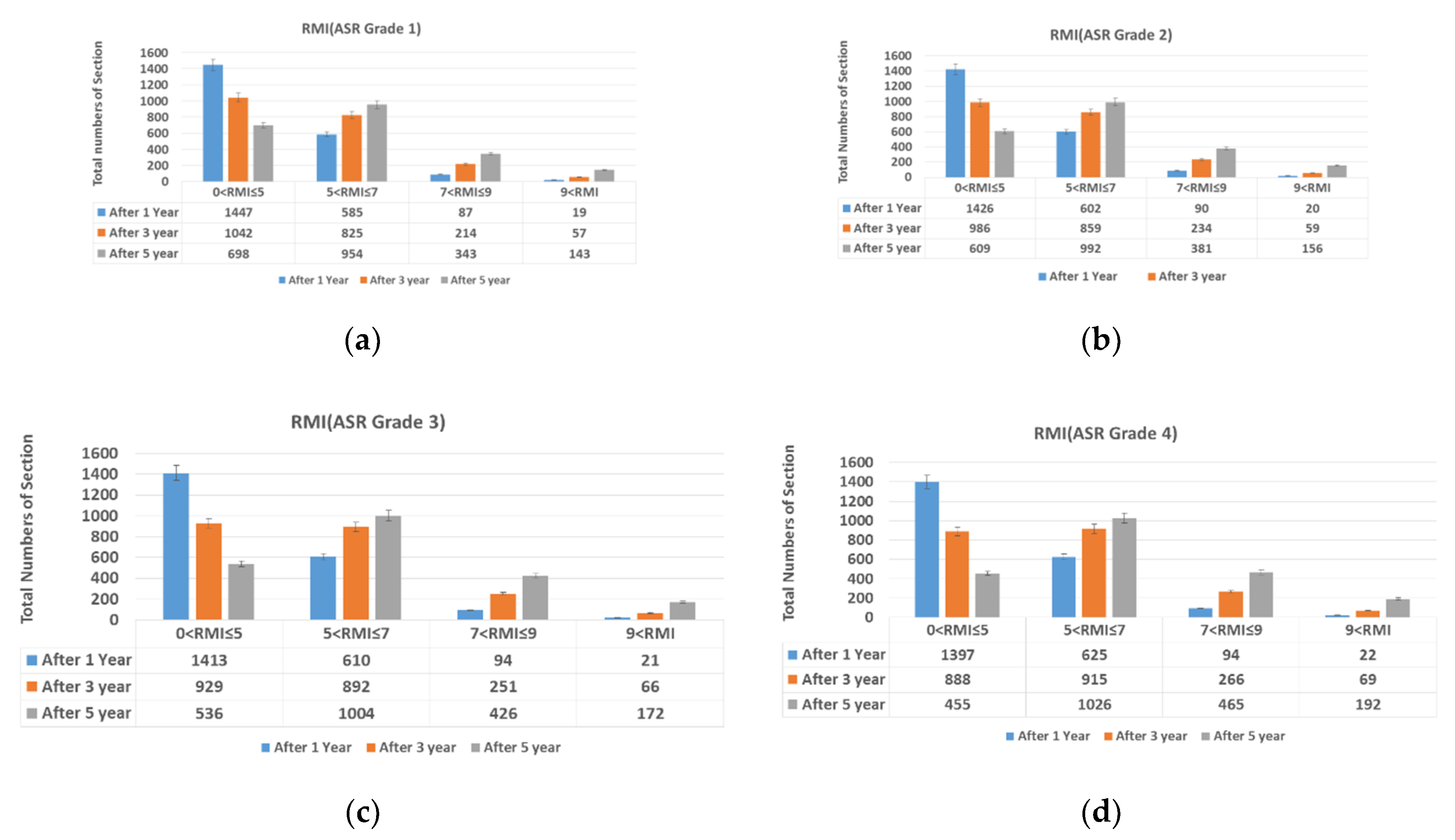
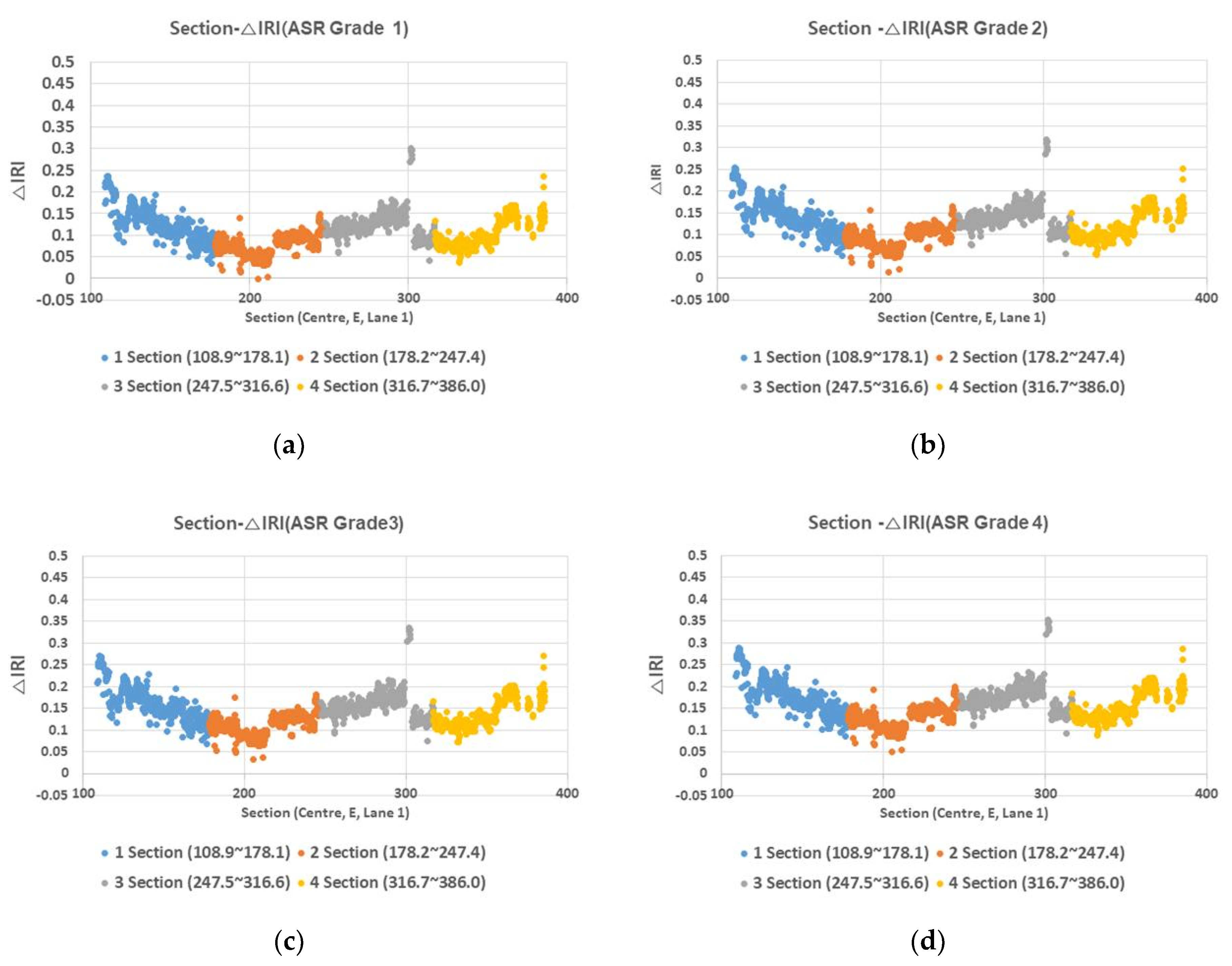

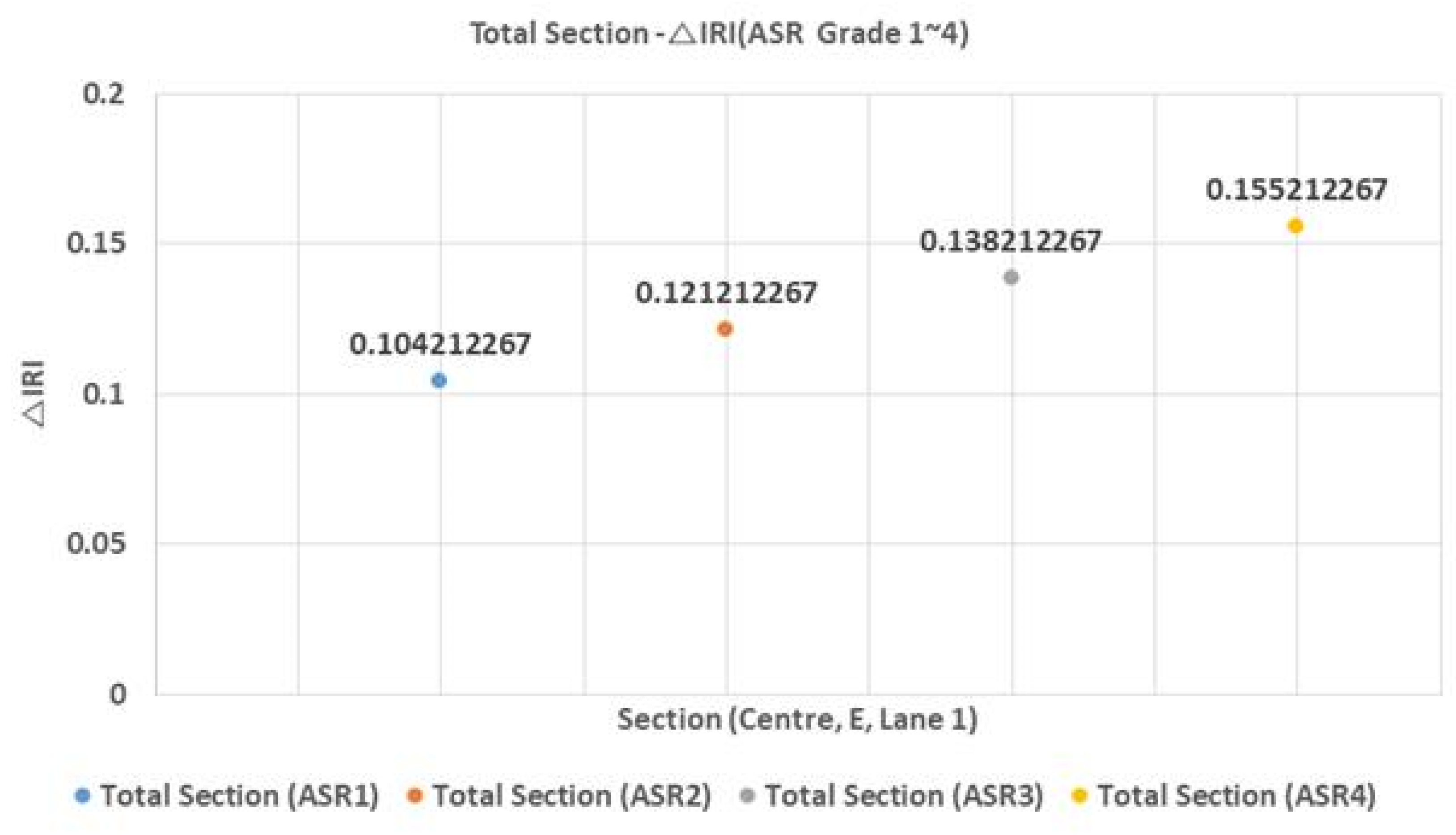
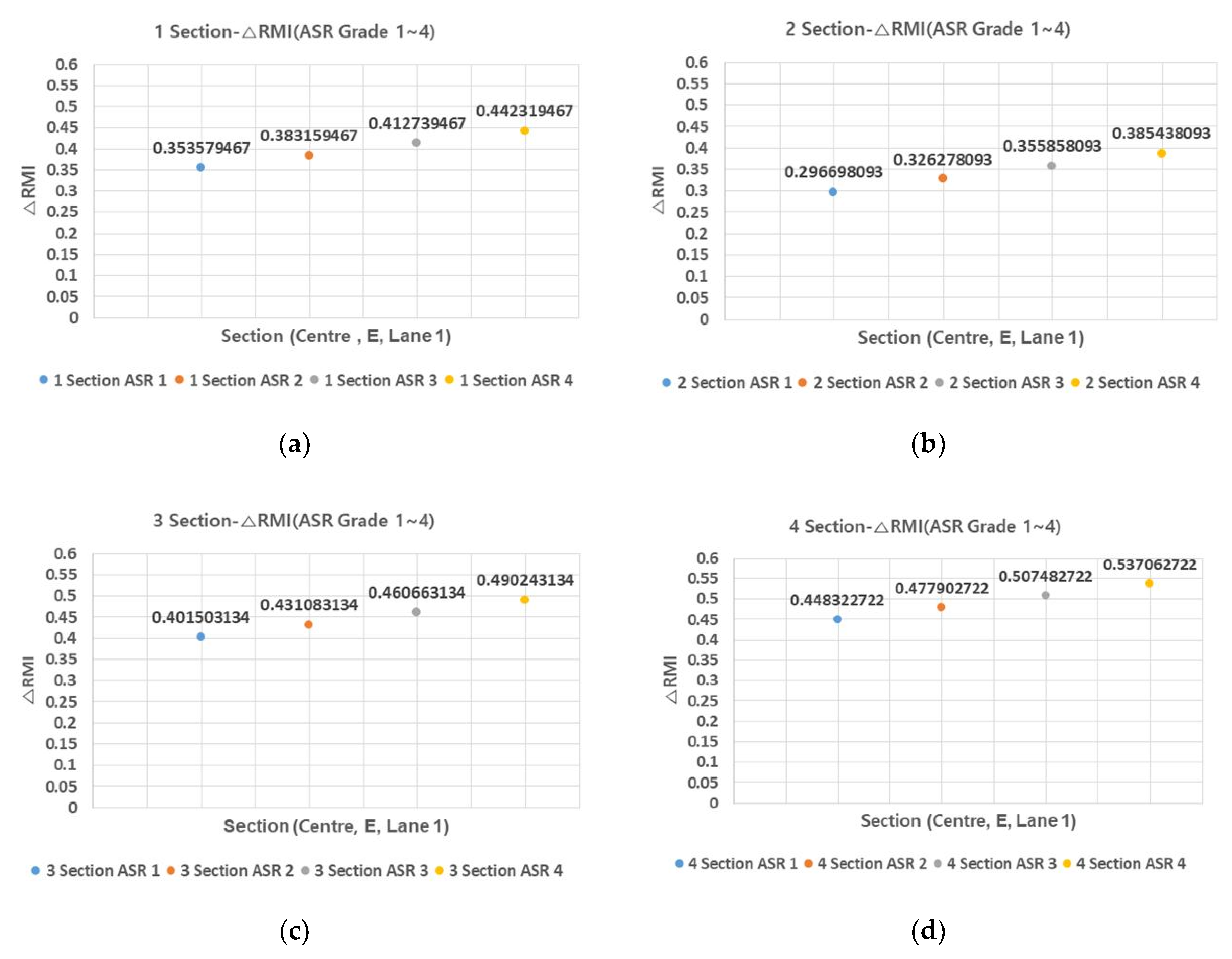
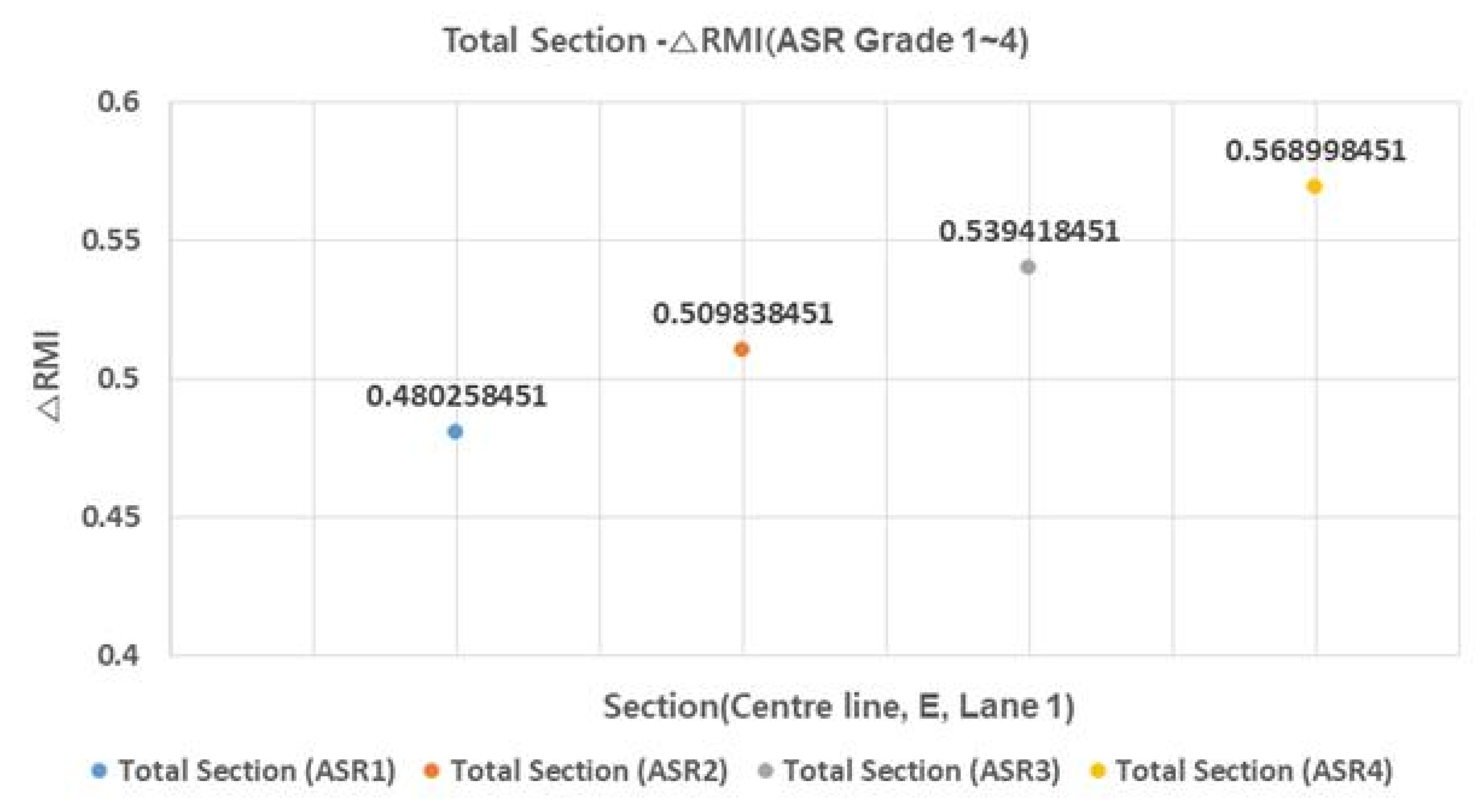
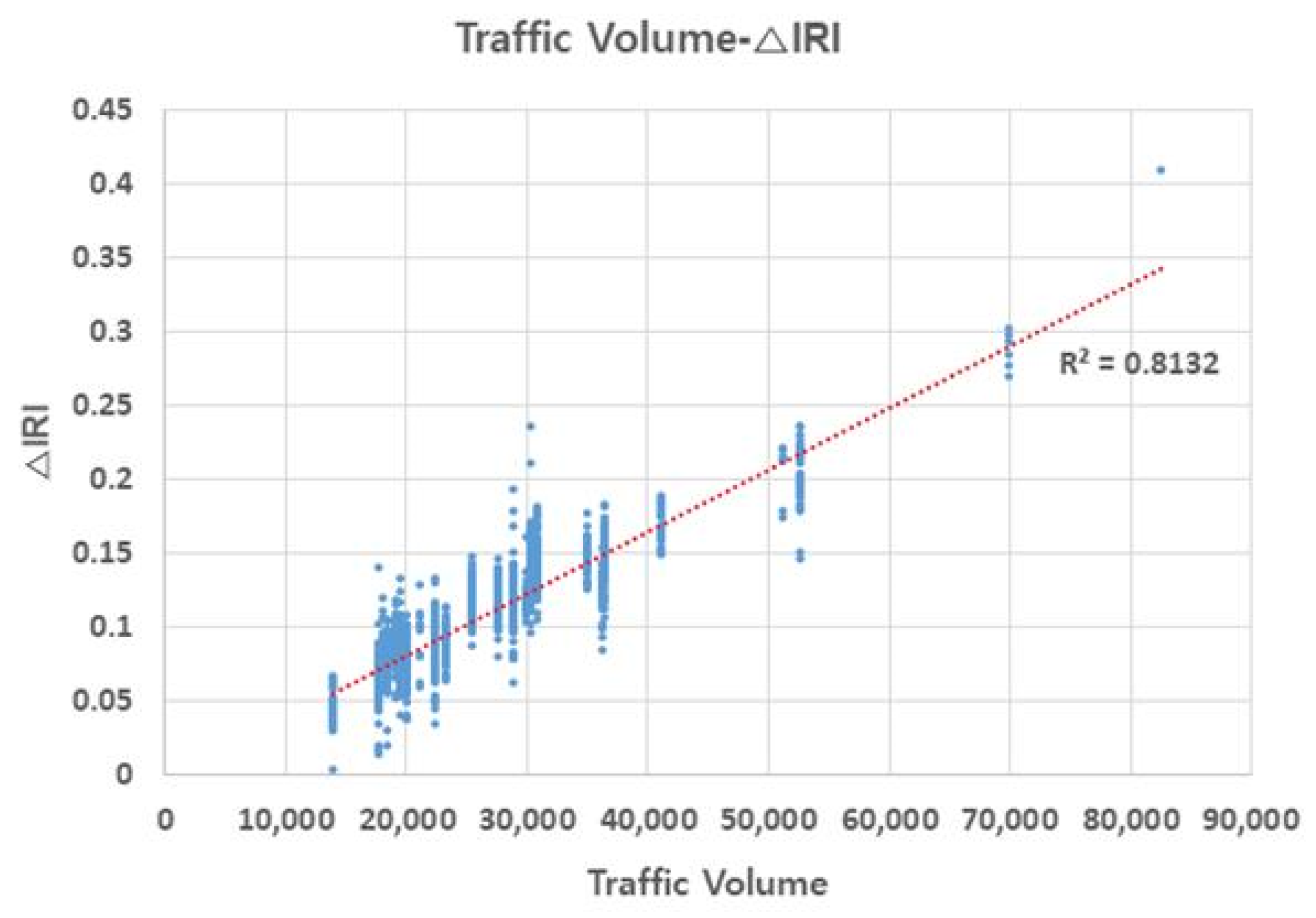
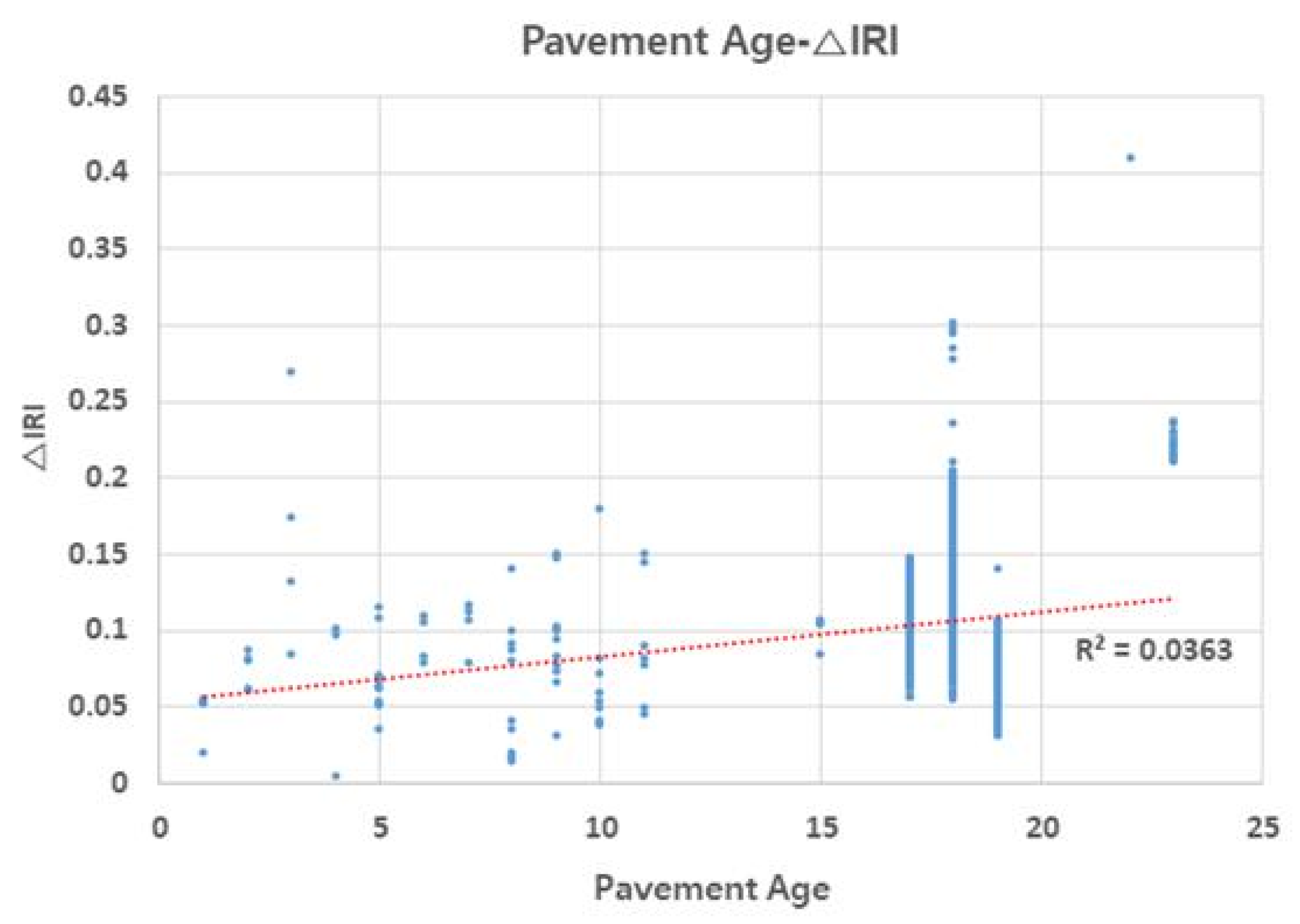
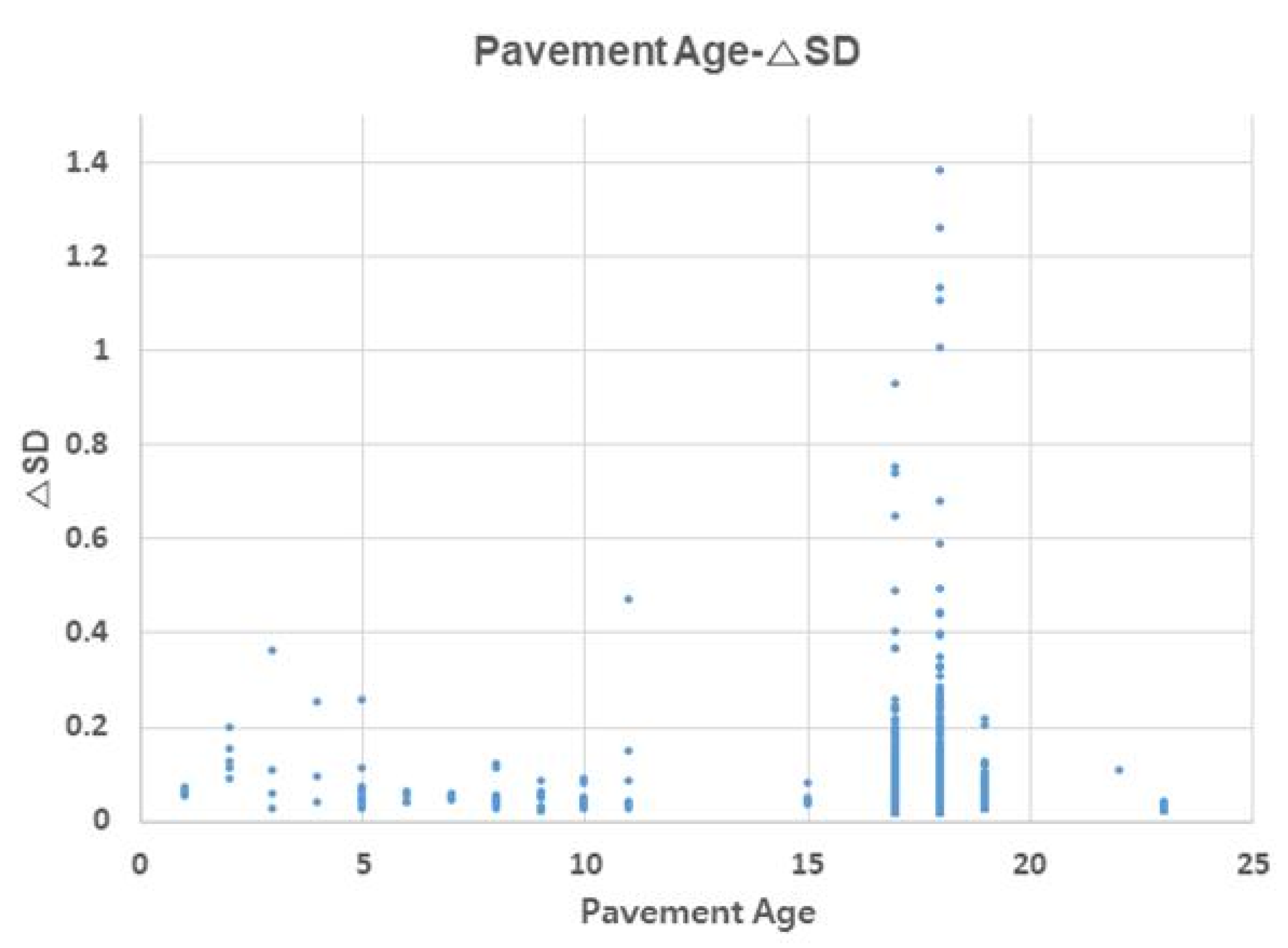
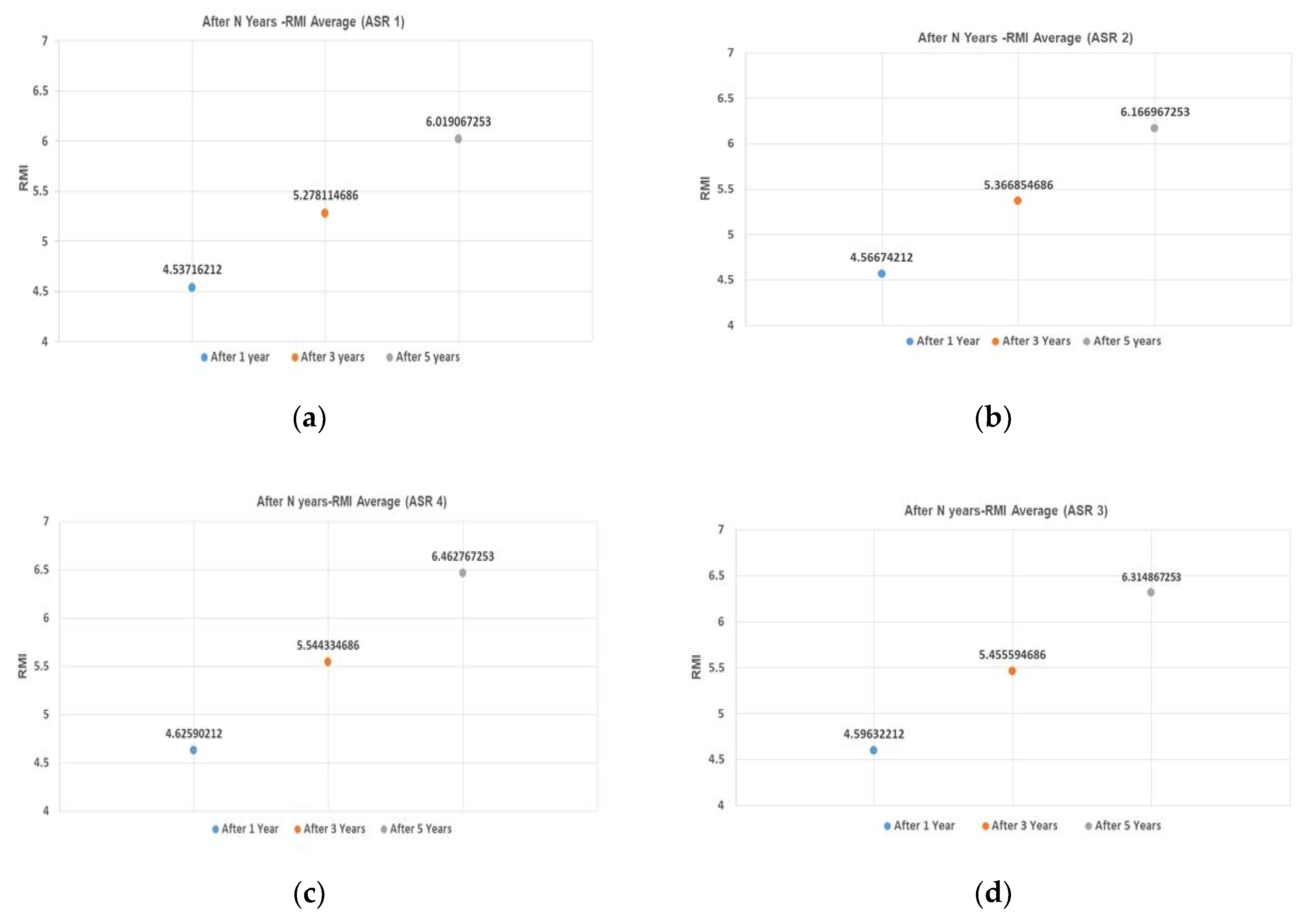
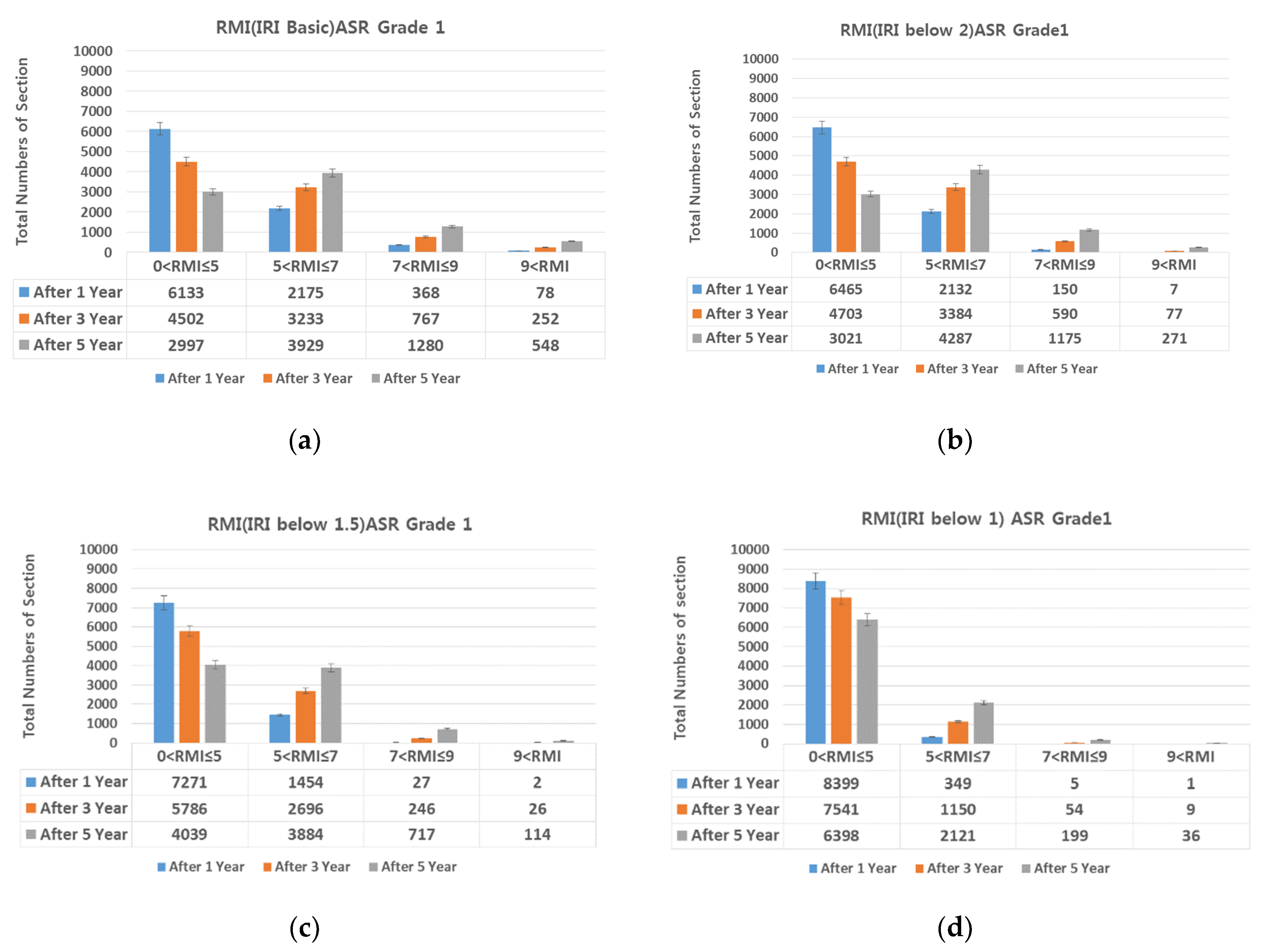
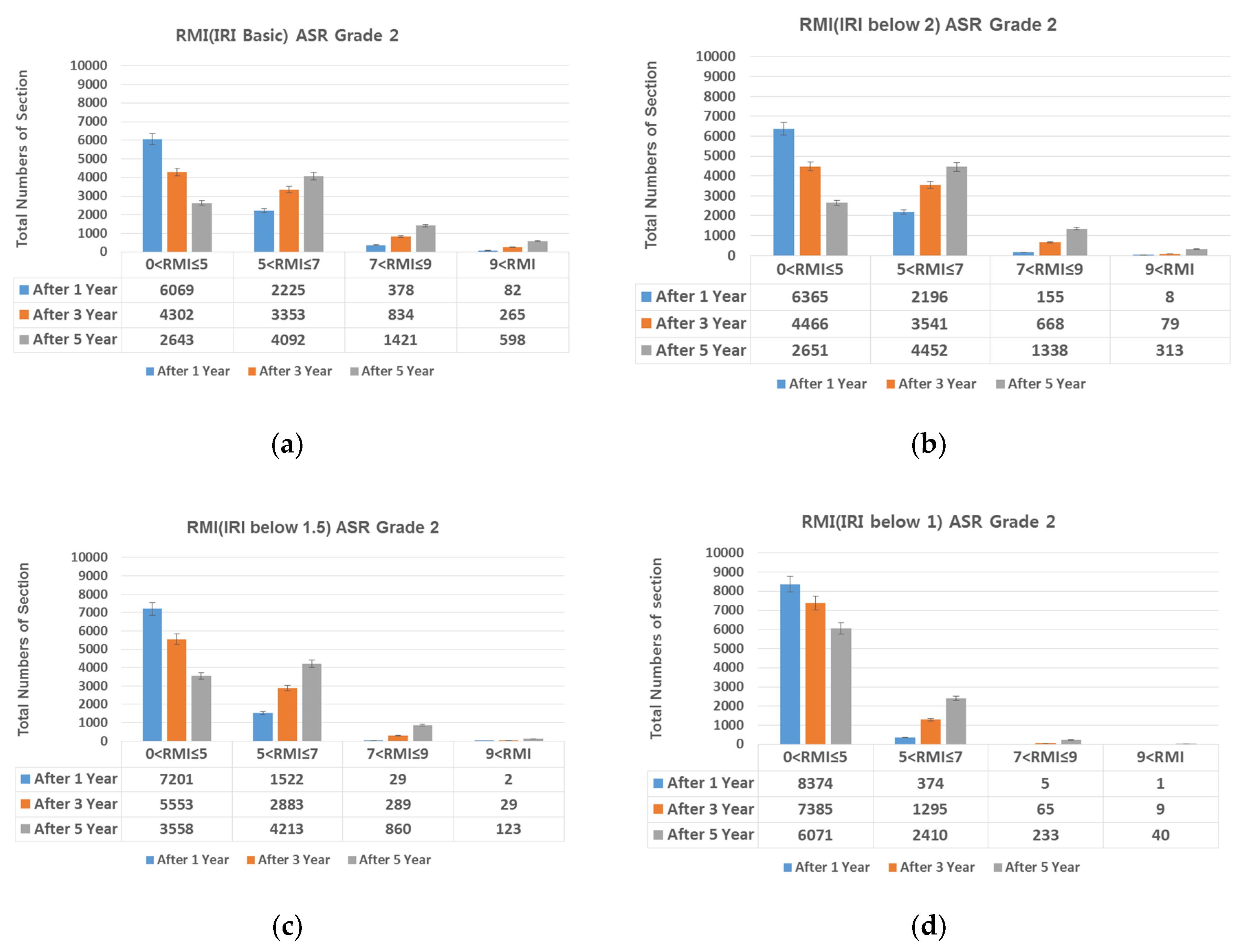
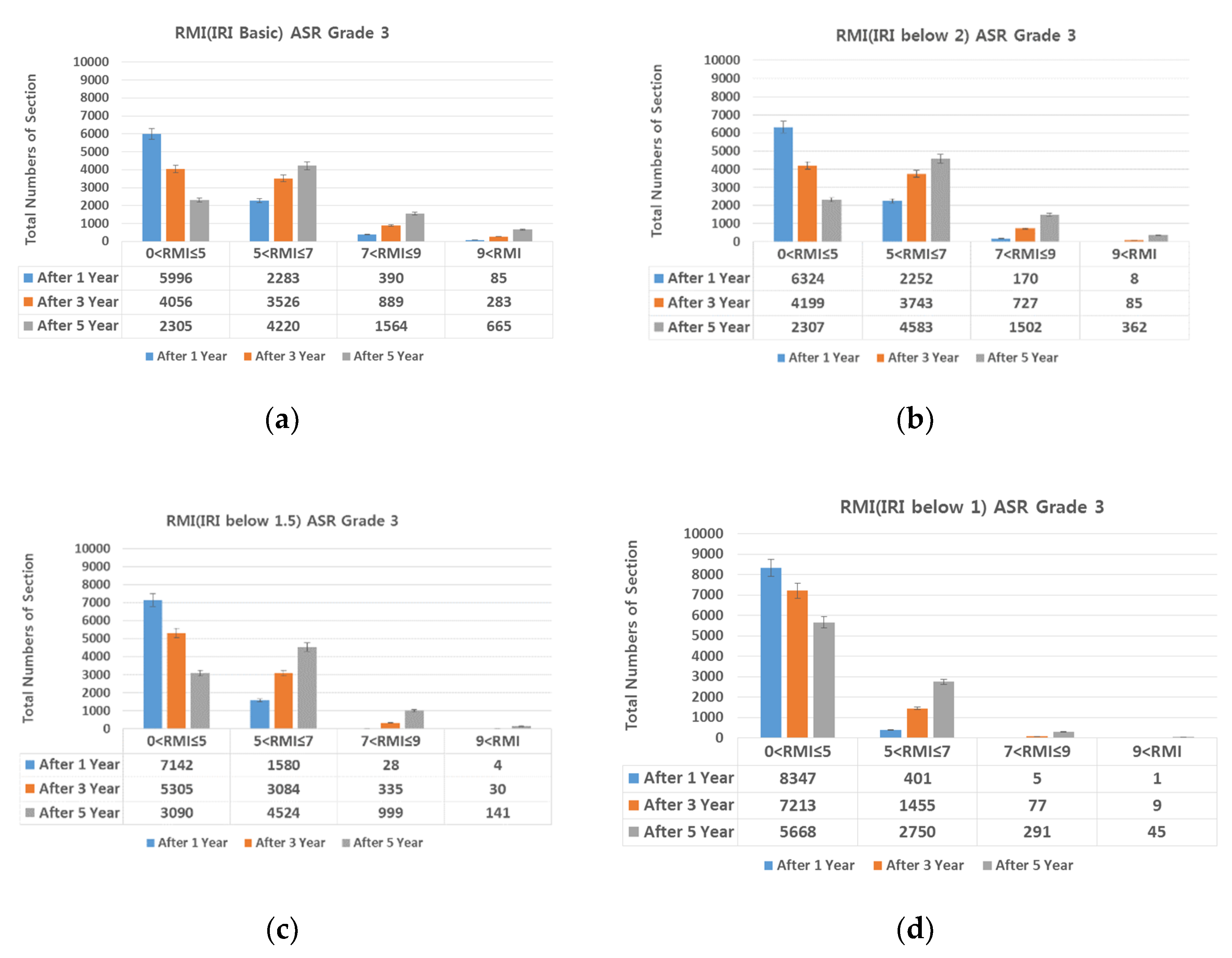
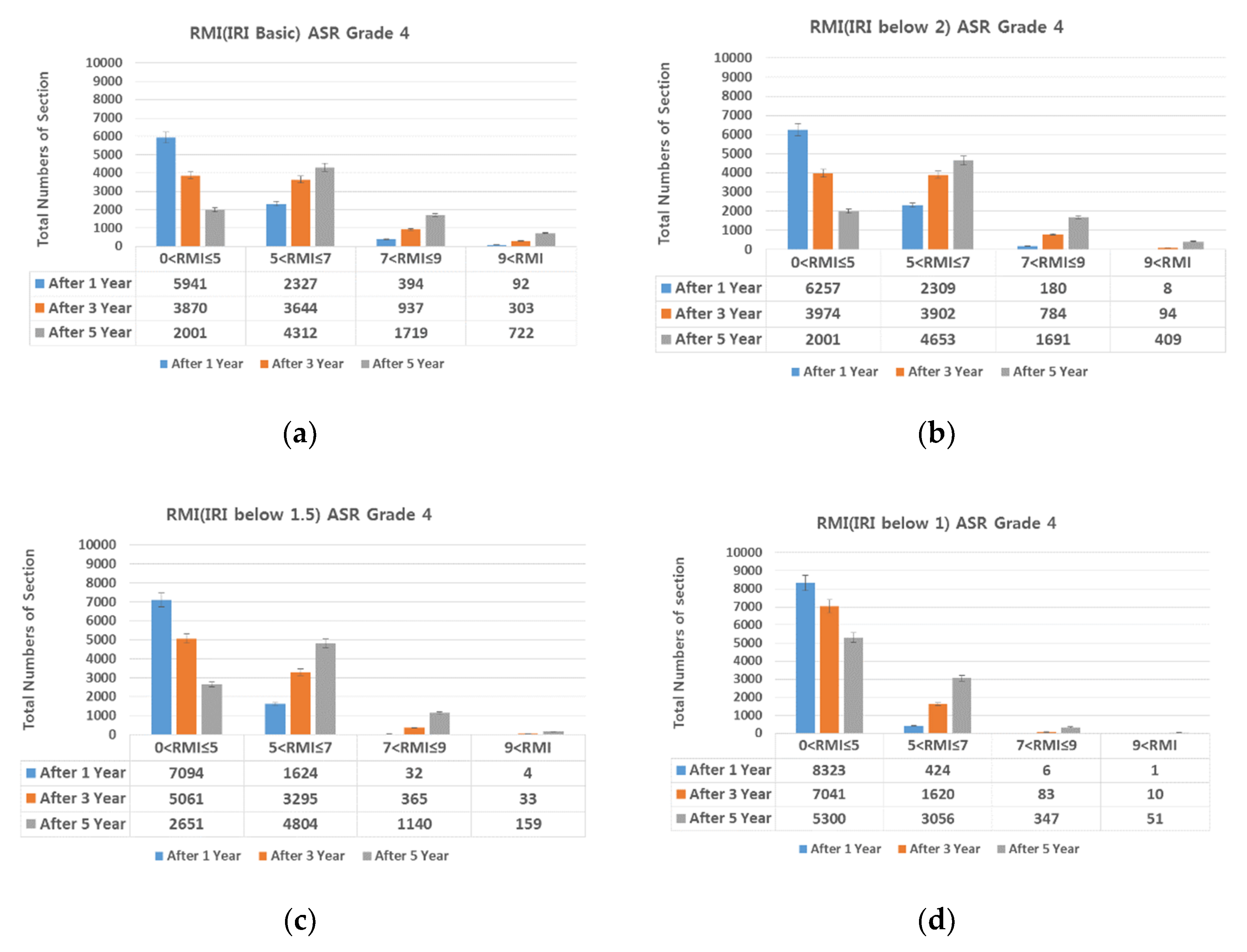

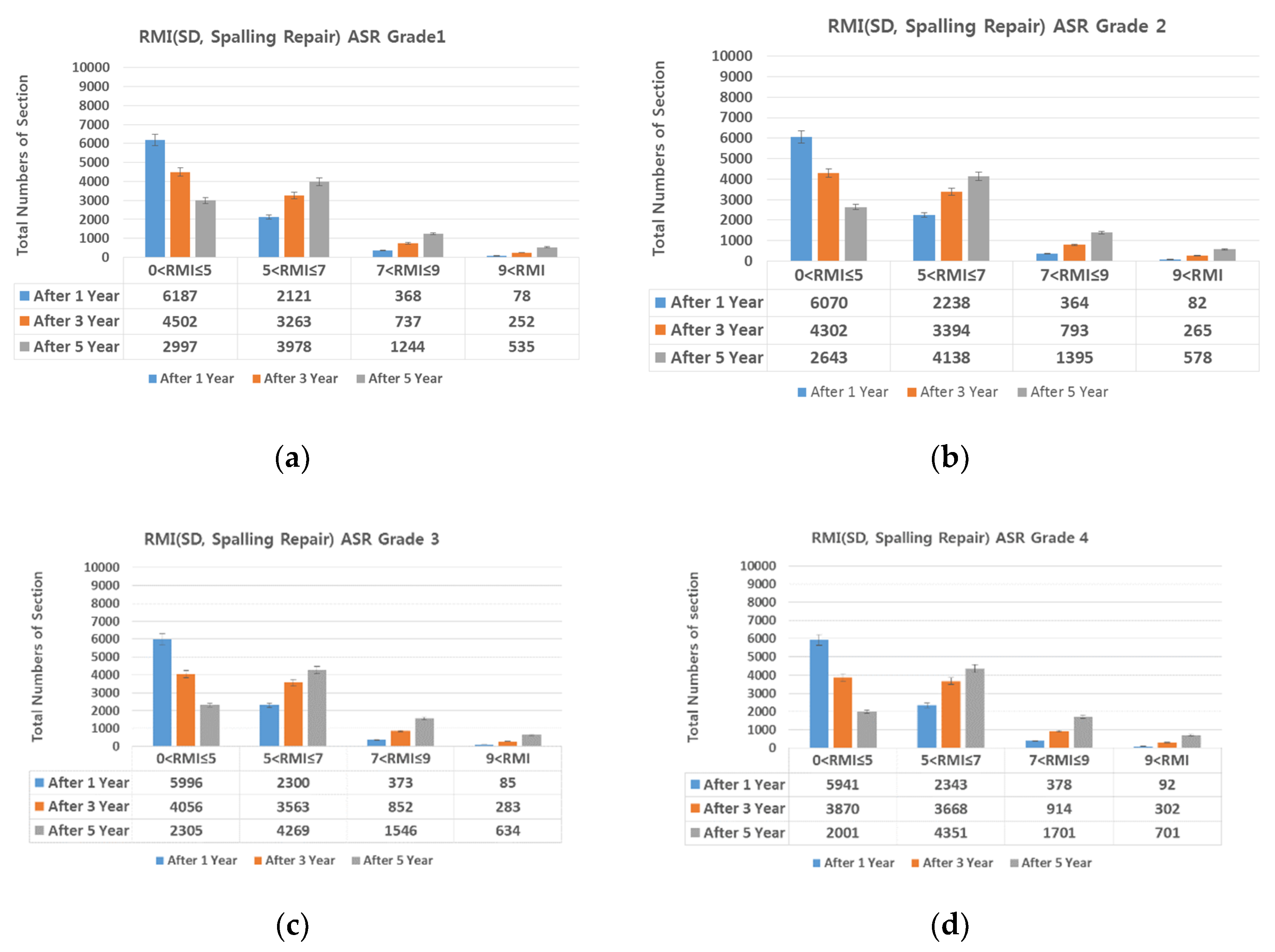

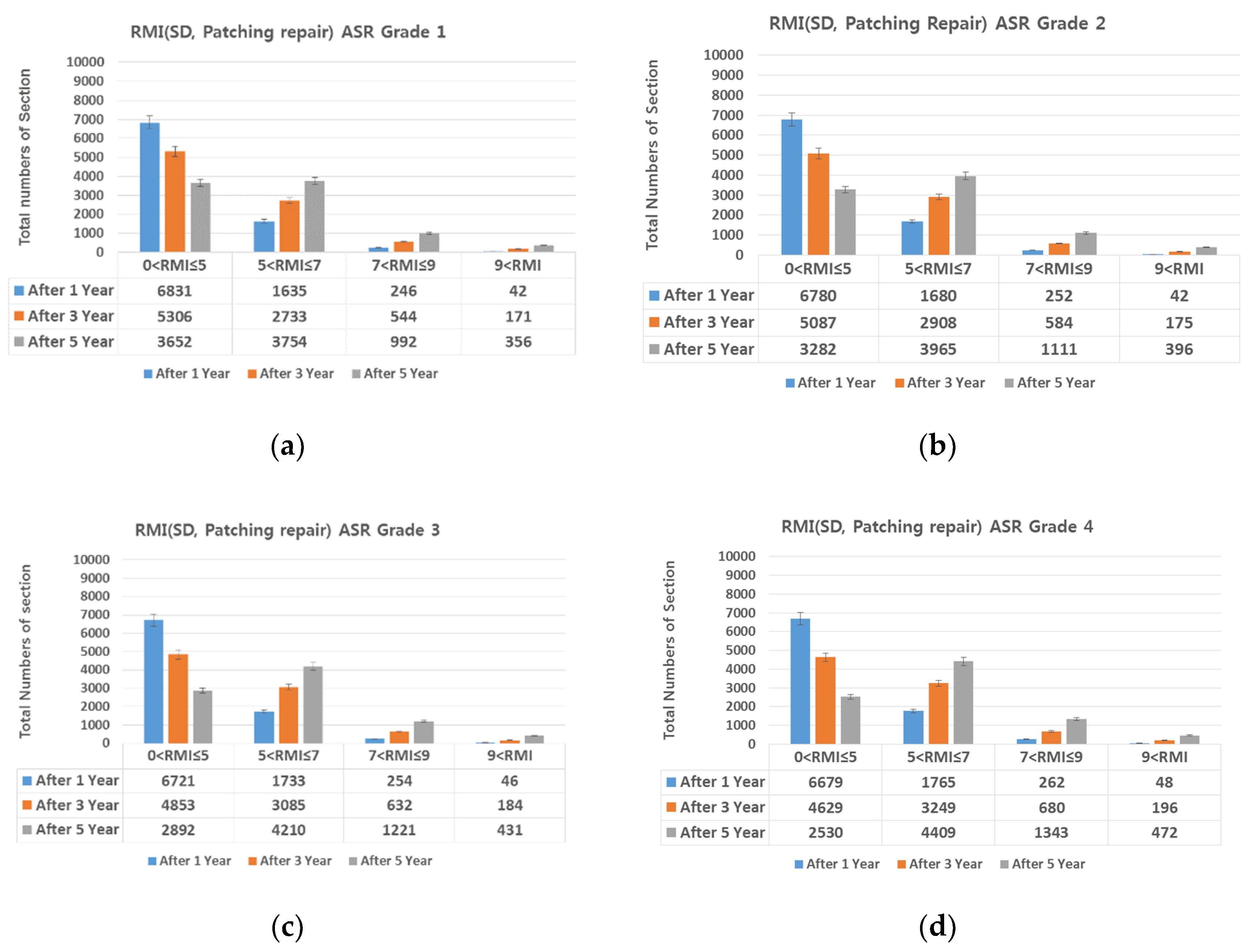

| RMI | Remodeling Urgency | Judgment Criteria | Recommended Repair Method |
|---|---|---|---|
| 9 < RMI | Urgent | With severe cracking, severe re-damage of partial/full depth repair | Re-paving or overlay |
| 7 < RMI ≤ 9 | Necessary | With considerable cracking, Considerable re-damage of partial/full depth repair | |
| 5 < RMI ≤ 7 | Considerable | In a comparatively moderate condition | Typical repair or overlay |
| 0 < RMI ≤ 5 | Unnecessary | - | - |
| ASR Grade | Appearance of Concrete Slab | Damage Slab Area (%) | Crack Width (mm) | Crack Spacing (mm) |
|---|---|---|---|---|
| 1 | -Some cracks and some reticular cracks occur in the slab | 1–9 | <0.5 | >1000 |
| -Check for signs of alkali-aggregate reaction (core collection) | ||||
| 2 | -Attack cracks and reticular cracks in slabs | 10–24 | 0.5–1 | 500–1000 |
| -Pop-out and spalling do not occur | ||||
| -Some horizontal cracks in the concrete pavement (core collection) | ||||
| 3 | -Attack cracks and reticular cracks in slabs | 25–49 | 1–5 | 100–500 |
| -Surface leakage of reactive gel | ||||
| -Some pop-out and spalling occur | ||||
| -A large number of heat generated inside the concrete slab (core collection) | ||||
| 4 | -Attack cracks and reticular cracks in slabs | More then 50 | >5 | <100 |
| -Surface leakage of reactive gel | ||||
| -Pop-out and spalling multiple occurrences | ||||
| -Horizontal pupil inside the concrete slab (core collection) |
| ASR Grade | Years | RMI Sections | |||
|---|---|---|---|---|---|
| 0 < RMI ≤ 5 | 5 < RMI ≤ 7 | 7 < RMI ≤ 9 | 9 < RMI | ||
| ASR 1 (Total number of sections) | After 1 year | 1447 | 585 | 87 | 19 |
| After 3 years | 1042 | 858 | 214 | 57 | |
| After 5 years | 698 | 954 | 343 | 143 | |
| ASR 2 (Total number of sections) | After 1 year | 1426 | 602 | 90 | 20 |
| After 3 years | 986 | 859 | 234 | 59 | |
| After 5 years | 609 | 992 | 381 | 156 | |
| ASR 3 (Total number of sections) | After 1 year | 1413 | 610 | 94 | 21 |
| After 3 years | 929 | 892 | 251 | 66 | |
| After 5 years | 536 | 1004 | 426 | 172 | |
| ASR 4 (Total number of sections) | After 1 year | 1397 | 625 | 94 | 22 |
| After 3 years | 888 | 915 | 266 | 69 | |
| After 5 years | 455 | 1026 | 465 | 192 | |
© 2020 by the authors. Licensee MDPI, Basel, Switzerland. This article is an open access article distributed under the terms and conditions of the Creative Commons Attribution (CC BY) license (http://creativecommons.org/licenses/by/4.0/).
Share and Cite
Jung, H.; Kim, Y.; Kim, S.; Park, C.; Nam, J.-H. Life Extension of Aged Jointed Plain Concrete Pavement through Remodeling Index–Based Analysis. Materials 2020, 13, 2982. https://doi.org/10.3390/ma13132982
Jung H, Kim Y, Kim S, Park C, Nam J-H. Life Extension of Aged Jointed Plain Concrete Pavement through Remodeling Index–Based Analysis. Materials. 2020; 13(13):2982. https://doi.org/10.3390/ma13132982
Chicago/Turabian StyleJung, Haekook, Yongjae Kim, Seungwon Kim, Cheolwoo Park, and Jeong-Hee Nam. 2020. "Life Extension of Aged Jointed Plain Concrete Pavement through Remodeling Index–Based Analysis" Materials 13, no. 13: 2982. https://doi.org/10.3390/ma13132982
APA StyleJung, H., Kim, Y., Kim, S., Park, C., & Nam, J.-H. (2020). Life Extension of Aged Jointed Plain Concrete Pavement through Remodeling Index–Based Analysis. Materials, 13(13), 2982. https://doi.org/10.3390/ma13132982





